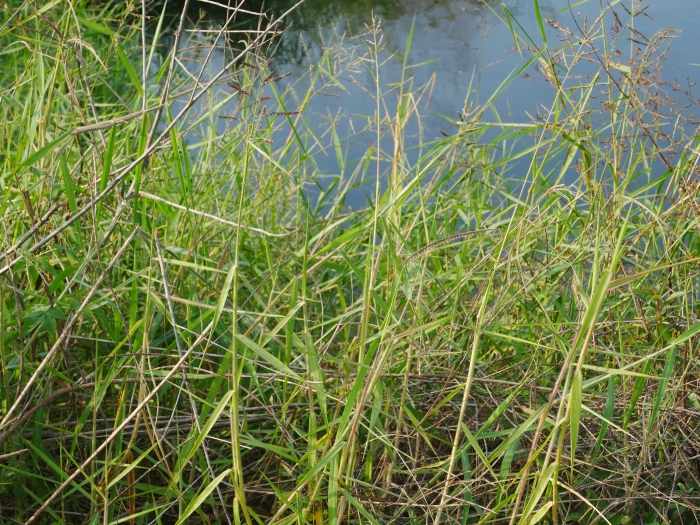Para Grass
(Urochloa mutica)
Para Grass (Urochloa mutica)
/
/

Jacy Chen
CC BY 4.0
Image By:
Jacy Chen
Recorded By:
Copyright:
CC BY 4.0
Copyright Notice:
Photo by: Jacy Chen | License Type: CC BY 4.0 | License URL: http://creativecommons.org/licenses/by/4.0/ | Rights Holder: Jacy Chen | Publisher: iNaturalist | Date Created: 2021-12-11T14:53:24-08:00 |

























Estimated Native Range
Summary
Urochloa mutica, commonly known as Para Grass or Buffalo Grass, is a semi-prostrate perennial grass originally native to Africa and parts of the Middle East. It is now widespread in tropical regions and is often found in wetlands, along riverbanks, and in other moist, open habitats. It typically forms dense mats with creeping stolons that can reach up to 16 feet in length, with hairy nodes and leaf sheaths. The flower-head is a loose panicle with elliptical spikelets, which are not particularly showy. The plant can grow quite tall, reaching heights of 2 to 4 feet.
Para Grass is valued for its use as fodder due to its rapid growth and high biomass production. It is also used for erosion control in wet areas. In cultivation, it requires abundant water and thrives in full sun to partial shade. It prefers fertile, moist soils and can tolerate waterlogged conditions. However, it is important to note that Para Grass can be invasive outside its native range, often outcompeting native vegetation and altering wetland ecosystems. It is considered a weed in many areas and can be difficult to control once established. Before planting, it is crucial to check local regulations and consider the environmental impact.CC BY-SA 4.0
Para Grass is valued for its use as fodder due to its rapid growth and high biomass production. It is also used for erosion control in wet areas. In cultivation, it requires abundant water and thrives in full sun to partial shade. It prefers fertile, moist soils and can tolerate waterlogged conditions. However, it is important to note that Para Grass can be invasive outside its native range, often outcompeting native vegetation and altering wetland ecosystems. It is considered a weed in many areas and can be difficult to control once established. Before planting, it is crucial to check local regulations and consider the environmental impact.CC BY-SA 4.0
Plant Description
- Plant Type: Grass
- Height: 2-6 feet
- Width: 3-6 feet
- Growth Rate: Rapid
- Flower Color: N/A
- Flowering Season: Summer, Fall
- Leaf Retention: Deciduous
Growth Requirements
- Sun: Full Sun, Part Shade
- Water: High
- Drainage: Fast, Medium, Slow
Common Uses
Erosion Control, Water Garden
Natural Habitat
Originally native to Africa and parts of the Middle East, now widespread in tropical wetlands and along riverbanks
Other Names
Common Names: Para Grass, Mauritius Signal Grass, Dutch Grass, Mauritius Grass, Scotch Grass, Scottish Grass, Buffalo Grass
Scientific Names: , Urochloa mutica, Brachiaria mutica, Brachiaria numidiana, Brachiaria purpurascens, Panicum amphibium, Panicum appressum, Panicum barbinode, Panicum equinum, Panicum equinum
GBIF Accepted Name: